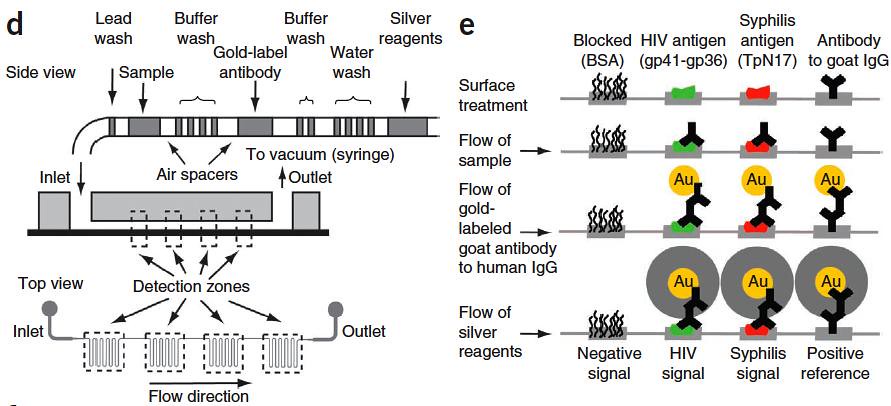Miniature lab can diagnose disease in the field
ALEXIS FLYNN, WILL CONNORS
People who live in the poorest and remotest parts of the developing world often have their lives cut short by disease -- preventable or curable disease. The first essential step to fighting these diseases is correctly identifying them. But in the developing world, disease detection is often prohibitively expensive. In a brilliant cross-pollination of engineering, physics and biology, scientists have developed an affordable credit-card sized device that can accurately diagnose HIV and syphilis in just minutes.
This device, known as the microfluidic chip, or mChip, requires just one microlitre of whole blood to detect specific diseases with comparable efficiency to bench-top assays but at a significantly lower cost. Further, mChip detection takes less than 20 minutes, whereas bench-top assays require several hours or more to complete. Developed by an international team of scientists headed by Samuel Sia, associate professor of Biomedical Engineering at Columbia University in New York City, mChip was successfully field tested in the African nation of Rwanda.
"The microfluidic design is very simple", said Dr Sia. "It's essentially a .. linear channel that's been looped around in various ways."
DOI: 10.1038/nm.2408 [enbiggen]
Above is a photograph of the mChip (Figure 1a). This credit card-sized cassette is manufactured from plastic and each mChip cassette can test seven samples (one per channel), and requires no moving parts, electricity or external instrumentation. Instead, it has small holes moulded into the plastic so reagent-loaded tubes can be attached. A scanning electron microscope image shows a cross-section of the microchannels that the blood and reagents flow through (made of injection-molded plastic [Scale bar, 500 μm]; Figure 1b) and a light micrograph shows a close-up of the channel meanders, which can be clearly seen with the naked eye (Scale bar, 1 mm; Figure 1c).
DOI: 10.1038/nm.2408 [embiggen]
The principles for how the mChip work are well known, straightforward and, quite frankly, beautiful.
"In different parts of this microfluidic channel, we have different zones where we pattern in a molecule that captures what we want to detect", Dr Sia said.
The mChip relies on the passive delivery of multiple reagents. These reagents (Figure 1d) are preloaded in the correct sequence in a narrow tube and separated from each other by an air bubble. These reagents pass over a series of four dense meanders, the mChip's detection zones, before exiting the chip into a disposable syringe. This manually controlled syringe generates the vacuum that pulls the blood and liquid reagents through the mChip's meanders.
The basic principle of the mChip's bioassay is based on the well-known and widely-used Enzyme-linked immunosorbent assay, ELISA, which produces a strong easily-detectable signal through enzyme-mediated signal amplification. Each mChip detection zone -- meander -- is coated with specific "capture proteins" that bind to antibodies against particular disease organisms (Figure 1e). If these antibodies stick, the series of reagents that passes over these antibody-antigen complexes then stick to them thereby amplifying the signal by creating an "immunosandwich" comprised of reduced silver ions stuck to gold nanoparticle-conjugated antibodies.
"At the end, the silver development reagent develops into solid silver if you have the gold nanoparticles captured on the surface", explained Dr Sia. "The thickness of the silver film that's formed reflects the amount of analyte that was originally in sample."
Depending on whether colour develops, the test can be read as either positive or negative with the naked eye, or it can be quantified using a low-cost optical analysis.
DOI: 10.1038/nm.2408 [embiggen]
The above figure shows the absorbance traces of a complete HIV-syphilis duplex test whilst the reagents pass through the detection zones (Figure 1f). In this graphic, the high optical density (OD) peaks indicate when the air bubble spacers pass through the detection zones. The train of preloaded reagents mimics the precise order in which specific reagents are added and removed from traditional ELISA plates. This particular sample was identified as HIV negative and syphilis positive (it was confirmed as correct against a reference standard).
Even though the mChip uses silver and gold, it is still very affordable -- essential for wide-spread use in the developing world.
"The material for making the cassette is just pennies in plastic and even the reagents -- because we use such low volumes -- only cost a few pennies", remarked Dr Sia. "We think that after packaging it together, it will cost a few dollars."
When field-tested on hundreds of people's samples in Rwanda, the mChip simultaneously diagnosed HIV and syphilis from individual one-microlitre samples of unprocessed whole blood with sensitivities and specificities that rival those of more expensive and time-consuming benchtop assays.
Unlike most current rapid tests, the mChip test does not require special training to interpret the signal. Overall, the mChip is a cost-effective and elegant integration of technologies for miniaturizing complex laboratory assays to diagnose and detect infectious diseases in remote settings.



